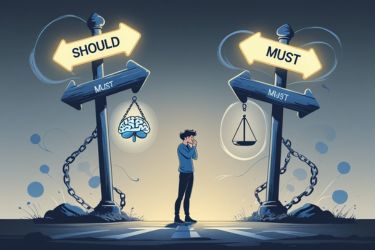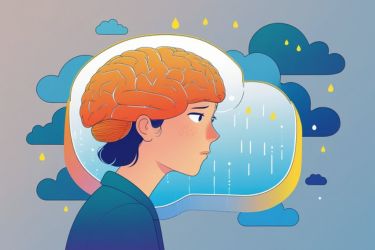Unhelpful thinking habits like magnification, catastrophising, and minimisation can greatly affect our mental health and how we view the world. These cognitive distortions often lead us to exaggerate problems or downplay successes, which can cause unnecessary stress and anxiety. By recognising these patterns, we can take steps to change our thinking for the better.

As we explore these habits, we will understand how they form and the impact they have on our daily lives. From viewing a small setback as a disaster to ignoring our achievements, these ways of thinking can trap us in a negative mindset. Learning to identify and challenge these thoughts is essential for our well-being.
We will also discuss practical strategies to tackle these thinking habits. With the right tools, we can shift to a more balanced and constructive view of ourselves and our circumstances. This journey towards clearer thinking will not only improve our mental health but also enhance our overall quality of life.
Key Takeaways
- Unhelpful thinking habits distort our perception of reality.
- Identifying these patterns is key to developing a healthier mindset.
- Practical strategies can help us challenge and change our thinking.
Understanding Unhelpful Thinking Habits

Unhelpful thinking habits can significantly influence our mental health and overall well-being. These patterns often lead to distorted perceptions and negative feelings. By recognising and understanding these cognitive distortions, we can begin to change our thought processes for the better.
What Are Cognitive Distortions?
Cognitive distortions are irrational thought patterns that reinforce negative thinking. They often stem from our beliefs and experiences, shaping how we view ourselves and the world. Common examples include black-and-white thinking, where we see situations in extremes, and personalisation, where we blame ourselves for events outside our control. These distortions can harm our self-esteem and create a cycle of negative thoughts.
The Impact of Negative Thoughts on Mental Health
Negative thoughts can have a serious impact on our mental health. When we engage in unhelpful thinking styles, we might experience increased anxiety or depression. For instance, catastrophising makes us believe that the worst outcome is inevitable, leading to heightened stress. These thoughts can create a feedback loop where negative emotions feed more negative thinking, making it hard to break free from this cycle. Understanding this connection helps us become more aware of our thought patterns.
Types of Unhelpful Thinking Styles
There are several unhelpful thinking styles that we may recognise in ourselves:
- Magnification: This involves exaggerating the importance of problems or perceived flaws.
- Minimisation: We may downplay our accomplishments or positive qualities, leading to reduced self-worth.
- Catastrophising: Imagining and expecting the worst possible outcomes can cloud our judgement and increase anxiety.
- Overgeneralisation: Drawing broad conclusions from a single event can lead to a negative mindset.
By identifying these styles, we can work on changing our thought processes to more constructive ones. Understanding unhelpful thinking habits empowers us to tackle them and improve our mental health.
Magnification and Catastrophising Explained

Magnification and catastrophising are two common unhelpful thinking habits that can distort our perception of situations. These patterns often lead us to focus on the worst possible outcomes, causing undue emotional distress and anxiety.
Defining Magnification
Magnification is when we inflate the importance of a negative event or our own mistakes. We may perceive minor setbacks as complete failures. This thinking style can lead to feelings of inadequacy and increased anxiety.
For instance, if we receive constructive criticism at work, we might believe we are entirely incompetent. This exaggerated thinking can prevent us from recognising our actual strengths and achievements. It is important to identify these automatic thoughts to break the cycle of negative thinking.
Catastrophising: Exaggerating the Worst
Catastrophising occurs when we jump to the worst possible conclusion without evidence. We often assume that if something can go wrong, it will go wrong. This mindset reinforces anxiety and emotional distress.
For example, if we make a mistake in a presentation, we might think, “I will never get another job.” Such thoughts can trap us in a loop of overgeneralisation, convincing us that future events will always end poorly.
Understanding this pattern helps us challenge these automatic thoughts and reduces our anxiety.
Real-World Examples of Magnification and Catastrophising
Let’s consider some real-world scenarios.
-
Job Interviews: After an interview, we might focus on a single question we answered poorly. We might think, “I have ruined my chances,” despite having done well overall.
-
Social Interactions: If a friend doesn’t respond immediately to a message, we can magnify this into thinking, “They must be upset with me.”
-
Exam Results: Receiving a grade lower than expected may lead to thoughts of failure in life, not just academics.
By recognising magnification and catastrophising in our lives, we can take steps to replace these negative automatic thoughts with more balanced perspectives. This helps us manage our emotions and reduce anxiety.
Minimisation and Other Cognitive Errors

Minimisation involves downplaying the significance of our achievements or experiences. This cognitive error can lead to negative thoughts and a distorted perception of reality. In this section, we will explore how to recognise minimisation, the related errors of discounting the positive and disqualifying the good, and how these thinking patterns compare to other cognitive errors.
Recognising Minimisation
We often fail to appreciate our accomplishments due to minimisation. This thinking style leads us to view our successes as less important or worthy of praise. For instance, we might think, "It was just luck" or "Anyone could have done it."
By recognising minimisation, we can begin to adjust our thought patterns. Keeping a journal of our achievements can help counter this negative self-talk. Writing down positive feedback we receive can also serve as an effective reminder of our worth.
Discounting the Positive and Disqualifying the Good
Discounting the positive goes hand in hand with minimisation. We might overlook or downplay positive experiences, believing they do not count. For example, after receiving a compliment, we might say, “They were just being nice.”
Disqualifying the good is another related error, where we reject positive outcomes or experiences as insignificant. This habit reinforces negative perceptions and can contribute to feelings of depression.
To combat this, we should practice acknowledging positive feedback and experiences, allowing ourselves to fully experience the good things in life.
Comparing Minimisation to Related Thinking Errors
Minimisation is closely linked to other cognitive errors like labelling and personalisation. Labelling involves assigning negative labels to ourselves, while personalisation is when we believe we are at fault for negative events beyond our control. Both can distort our perception of reality.
These thinking errors can lead to broad conclusions about ourselves and our abilities. For example, thinking we are incapable of success based on one failure can trap us in a cycle of negativity.
By differentiating minimisation from these related errors, we can focus on addressing our thinking more effectively. Understanding how these patterns interact helps us recognise when we are engaging in unhelpful thinking.
Origins and Effects of Unhelpful Thinking

Unhelpful thinking habits, like magnification, catastrophising, and minimisation, often stem from our experiences and beliefs. These thoughts can create negative emotions and reinforce mental health issues. Understanding how they develop can help us address them more effectively.
How Automatic Thoughts Develop
Automatic thoughts emerge from our past experiences and the way we interpret them. These thoughts can be either positive or negative, but we often find ourselves focusing on the negative. For example, if we receive criticism, we might instantly think, "I am a failure."
This negative thinking can become a habit, reinforcing itself over time. Our memories of past events shape these automatic negative thoughts. Each time we encounter a similar situation, our brain retrieves these thoughts, making them more likely to arise.
This cycle can lead to a pattern of unhelpful thinking. By recognising these patterns, we can take steps to change them.
The Role of Self-Esteem and Core Beliefs
Low self-esteem significantly contributes to unhelpful thinking styles. When we view ourselves negatively, we are more likely to adopt critical thoughts. Core beliefs, which are deeply held views about ourselves and the world, play a key role in this process.
For example, if we believe we are unworthy, we may magnify the impact of minor mistakes. These core beliefs are often formed in childhood, influenced by our experiences and interactions with others.
Challenging these core beliefs can help break the cycle of negative thinking. Strengthening our self-esteem can also lead to healthier thought patterns and improved emotional well-being.
Link to Anxiety, Depression, and Emotional Distress
Unhelpful thinking habits are closely linked to mental health issues like anxiety and depression. Catastrophising and minimising can intensify feelings of fear and sadness, making it difficult for us to cope.
When we adopt automatic negative thoughts, we may also experience increased emotional distress. For instance, if a minor setback leads us to think, "I’ll never succeed," it can trigger feelings of hopelessness.
This cycle can create learned helplessness, where we feel powerless to change our situation. Addressing these unhelpful thoughts becomes essential for improving our mental health and emotional resilience. By recognising their origins and effects, we can work towards more balanced thinking.
Challenging and Changing Unhelpful Thinking Patterns
Changing unhelpful thinking patterns is essential for improving our mental well-being. We can achieve this through various techniques and insights that help us cultivate a more positive mindset. Let's explore specific strategies to challenge our negative thoughts effectively.
Cognitive Restructuring Techniques
Cognitive restructuring involves identifying and changing distorted thoughts. We often magnify our problems or minimise our strengths. By recognising these patterns, we can work to reframe them.
A practical approach is to list our negative thoughts and evidence supporting or contradicting them. For example, if we think, “I never do anything right,” we can write down instances where we succeeded. This method helps challenge these unhelpful beliefs, giving us a clearer perspective. Tools like journals can support this process.
Alternative Explanations and Problem-Solving Skills
When we encounter setbacks, it’s crucial to consider alternative explanations. This helps us avoid jumping to conclusions that may not be accurate. We can ask ourselves, “What are other reasons this happened?” or “What could I learn from this situation?”
Developing problem-solving skills also aids in reframing our mindset. We can break challenges into smaller, manageable parts. This allows us to tackle problems step by step. Creating a list of possible solutions can foster a proactive approach rather than a reactive one, making us feel more in control.
Building a More Helpful Mindset
To build a helpful mindset, we should focus on our strengths and achievements. Practising gratitude daily can enhance our outlook on life. By acknowledging the things we appreciate, we shift our focus from negative thoughts to positive experiences.
Engaging in positive self-talk is essential. Instead of using harsh criticism, we can replace these thoughts with encouraging and affirming statements. For instance, instead of saying, “I failed,” we can say, “I tried my best, and I can improve next time.” This shift reinforces a growth mindset.
Role of Self-Awareness in Thought Change
Self-awareness plays a vital role in challenging our thinking patterns. By recognising our thoughts and feelings, we can identify when we’re engaging in unhelpful habits. We should regularly check in with ourselves, asking what we think and how we feel in different situations.
Mindfulness practices, such as meditation, can enhance our self-awareness. These practices help us observe our thoughts without judgment. As we become more aware, we can more easily implement cognitive restructuring techniques and develop healthier thinking habits. Keeping a thought diary can also aid in tracking our progress.
Therapeutic Approaches to Address Unhelpful Thinking
We can effectively tackle unhelpful thinking habits using various therapeutic methods. These approaches help us understand and modify our thoughts, leading to improved emotional well-being. Cognitive Behavioural Therapy (CBT) is particularly notable for its practical techniques and structured approach. Other evidence-based psychotherapies also contribute valuable insights. Influential theorists and their models guide many of these treatments.
Cognitive Behavioural Therapy and Its Effectiveness
Cognitive Behavioural Therapy (CBT) focuses on identifying and changing negative thought patterns. Developed by Aaron Beck, CBT helps us recognise cognitive distortions like all-or-nothing thinking, fortune telling, and mind reading. By challenging these thoughts, we can replace them with more balanced views.
CBT involves techniques such as cognitive restructuring. This process allows us to evaluate the evidence for our thoughts and consider alternative explanations. For example, instead of believing we must succeed at everything, we learn to accept that setbacks are a part of life.
Research shows that CBT is effective in treating various mental health issues, such as anxiety and depression. It equips us with tools to manage our thoughts and ultimately leads to better emotional regulation.
Other Evidence-Based Psychotherapies
In addition to CBT, several other evidence-based therapies can address unhelpful thinking. These include Acceptance and Commitment Therapy (ACT) and Dialectical Behaviour Therapy (DBT). ACT teaches us to accept our thoughts and feelings rather than fight them. By doing so, we can reduce the power they have over us.
DBT focuses on developing skills such as mindfulness and emotional regulation. These skills help us respond to stress without resorting to unhelpful thinking patterns. Studies show that these therapies can also be effective in changing our thought processes and improving our mental health.
Influential Theorists and Models
Several theorists have significantly contributed to our understanding of unhelpful thinking. Aaron Beck's cognitive model emphasises that our thoughts influence our emotions and behaviours. This model helps us see how distorted thinking can lead to negative feelings.
Albert Ellis, founder of Rational Emotive Behaviour Therapy (REBT), proposed that irrational beliefs fuel emotional distress. His ABC model highlights the connection between activating events, beliefs, and consequences.
By understanding these theories, we gain insight into our mental processes. This knowledge empowers us to identify unhelpful thinking and apply therapeutic strategies effectively.
Frequently Asked Questions
Understanding unhelpful thinking habits like magnification, catastrophising, and minimisation can help us recognise and manage these patterns. We will address common questions about identifying and adjusting these thought processes.
How can one identify and challenge magnification in their thought processes?
To identify magnification, we should pay attention to moments when we blow situations out of proportion. We often take a single negative event and see it as a disaster.
Challenging this involves questioning the evidence behind our thoughts. We can ask ourselves if the situation is really as dire as we think and look for counter-evidence.
In what ways does catastrophising impact an individual's decision-making?
Catastrophising can lead to poor decision-making because we may feel overwhelmed by fear. Our anxiety may prevent us from seeing all options available.
When we focus solely on negative outcomes, we might avoid taking necessary risks or pursuing opportunities. Addressing this thinking can help us make clearer, more rational choices.
Can minimisation tendencies be altered, and if so, how?
Yes, minimisation tendencies can be altered through awareness and practice. Recognising when we downplay our achievements is the first step.
We can journal about our successes, no matter how small, to reinforce their importance. Seeking feedback from trusted friends can also help validate our accomplishments.
What strategies are effective in managing the cognitive error of magnifying or minimising one's experiences?
We can use cognitive-behavioural techniques to manage these errors. Keeping a thought diary helps us track and challenge unhelpful thoughts regularly.
Practising mindfulness can also ground us in the present moment, making it easier to assess situations realistically. Regular self-reflection is key to adjusting our thoughts.
How do unhelpful thinking styles like catastrophising differ from other cognitive distortions?
Catastrophising is a specific form of cognitive distortion focused on imagining the worst possible outcomes. Other cognitive distortions, like black-and-white thinking, can involve viewing situations in extremes without considering the middle ground.
Understanding this helps us identify which exact patterns we may be experiencing. Recognising the uniqueness of each distortion allows for better targeted strategies.
What are practical steps someone can take to recognise and adjust catastrophising thoughts?
To recognise catastrophising thoughts, we should monitor our self-talk for phrases like "What if…" or "I can’t handle…"
We can challenge these thoughts by asking if they are realistic. Replacing them with more balanced statements can help us view situations in a more neutral light. Regular practice of this technique is vital for improvement.




















